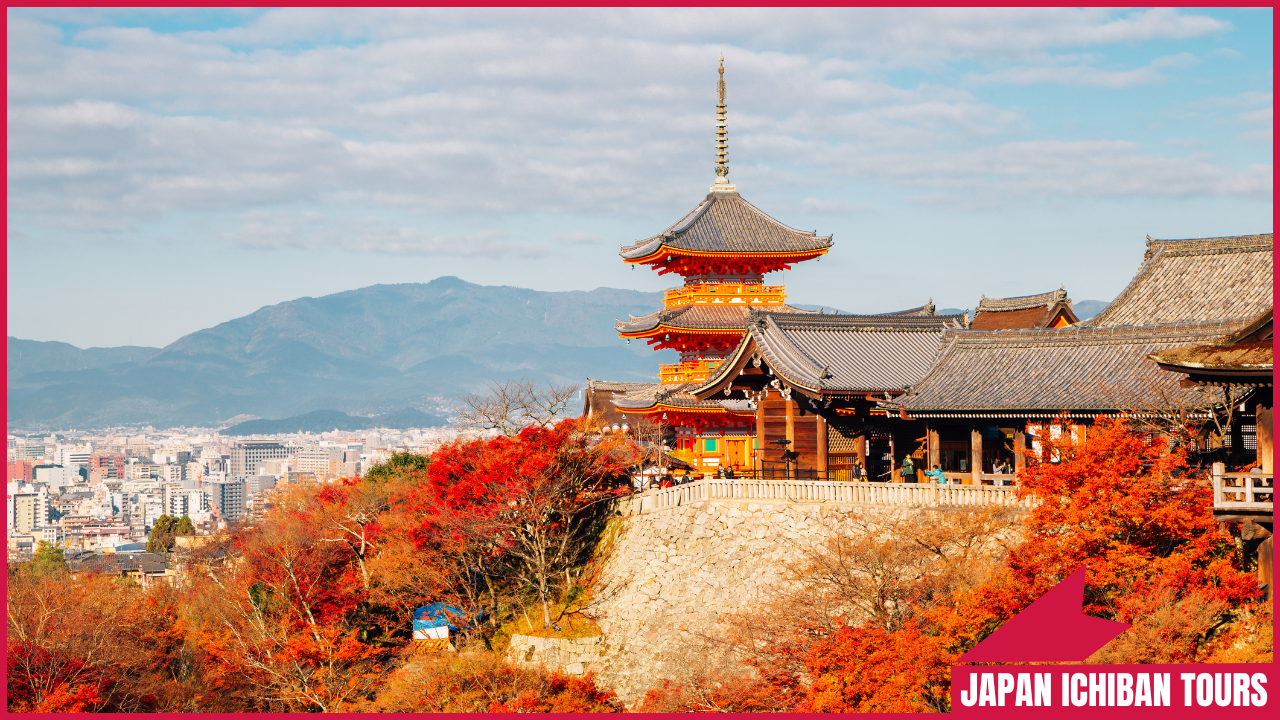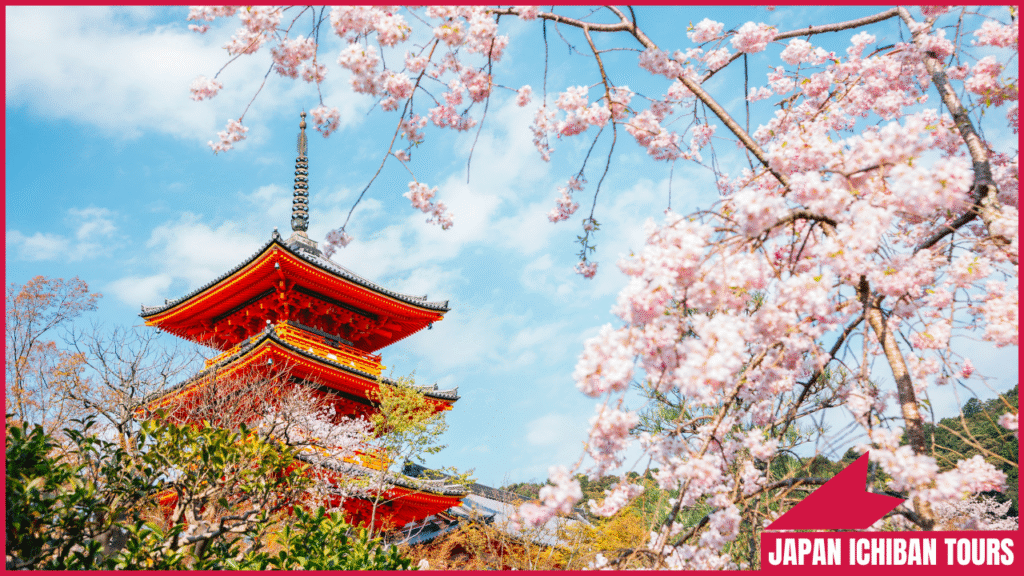
Kyoto, Japan’s cultural heart, is a treasure trove of over 2,000 temples and shrines, 17 UNESCO World Heritage sites, and stunning natural landscapes.
In 2025, Kyoto blends ancient traditions with modern accessibility, offering vibrant festivals, enhanced English signage, and efficient transit.
From iconic landmarks like Fushimi Inari Taisha to hidden gems like Kurama-dera, this guide highlights the top things to see in Kyoto, with insider tips for an unforgettable adventure.
For personalized guided tours, visit Japan Ichiban Tours at japanichibantours.com.
Kyoto’s 1,200-year history as Japan’s former capital shines through its serene temples, vibrant festivals like Gion Matsuri (July), and seasonal beauty—cherry blossoms (March–April) and autumn foliage (October–November).
With a compact layout and excellent public transit (Kyoto City Bus & Subway Pass, ~$10/day), it’s ideal for exploring. Whether you’re a culture enthusiast, nature lover, or foodie, Kyoto’s diverse attractions cater to all. Where to Find Halal Food in Japan (Tokyo, Osaka & More)
Location: Southern Kyoto
Cost: Free
Why See It: This UNESCO-associated Shinto shrine, dedicated to the god of prosperity, is famous for its thousands of vibrant red torii gates winding up Mount Inari. The 2–3-hour hike through forested paths offers spiritual serenity and city views, making it Kyoto’s most iconic landmark.
Pro Tip: Book a guided hike with Japan Ichiban Tours at japanichibantours.com for cultural insights.
Location: Northern Kyoto
Cost: ~$4
Why See It: A UNESCO World Heritage Zen Buddhist temple, Kinkaku-ji dazzles with its gold-leaf-covered upper floors reflecting in a tranquil pond. Surrounded by manicured gardens, it’s a symbol of Kyoto’s spiritual and aesthetic heritage.
Location: Eastern Kyoto
Cost: ~$4
Why See It: This UNESCO World Heritage temple, perched on a hillside, features a wooden stage with sweeping Kyoto views. Its sacred Otowa waterfall, where visitors drink for health, love, or success, adds spiritual allure. Nearby Sannen-zaka and Ninnen-zaka streets offer traditional shops.
Pro Tip: Explore Gion with a guided tour from japanichibantours.com for geisha culture insights.
Location: Western Kyoto
Cost: Free (Tenryu-ji Temple ~$5)
Why See It: The Arashiyama Bamboo Grove’s towering green pathways create an ethereal escape, perfect for photography and peaceful strolls. Nearby Tenryu-ji Temple, a UNESCO site, and Togetsukyo Bridge add cultural depth.

Location: Northern Kyoto
Cost: ~$2 (main hall), free for trails
Why See It: Nestled in northern Kyoto’s forested hills, Kurama-dera offers a serene escape with fewer crowds. Reachable by a scenic hike or cable car (~$2), it’s tied to tengu myths and features stunning mountain views. The nearby Kurama Onsen (~$15) adds relaxation.
Pro Tip: Book a guided hiking tour with Japan Ichiban Tours at japanichibantours.com for a deeper experience.
Location: Eastern Kyoto
Cost: ~$5
Why See It: Ginkaku-ji, a UNESCO Zen temple, embodies wabi-sabi aesthetics with its understated wooden pavilion and moss gardens. The Philosopher’s Path nearby is stunning during cherry blossom season.
Location: Gion, Central Kyoto
Cost: Free
Why See It: Yasaka Shrine, founded over 1,350 years ago, is a spiritual hub hosting the Gion Matsuri (July). Its vibrant lanterns and central location make it a must-see, especially at night.
Location: Central Kyoto
Cost: Free (food ~$2–$10)
Why See It: This 400-meter market alley offers fresh sushi, matcha sweets, and kyo-ryori (Kyoto cuisine). It’s a foodie’s paradise for tasting tamagoyaki (~$3) or yuba (~$5).
Pro Tip: Join a food tour with Japan Ichiban Tours at japanichibantours.com for curated tastings.
Location: Southern Kyoto
Cost: ~$4
Why See It: A Zen temple known for its Tsutenkyo Bridge, Tofuku-ji offers breathtaking autumn foliage views in October–November. Its gardens and architecture are a UNESCO highlight.
Location: Eastern Kyoto
Cost: Free (Sanmon Gate ~$5, sub-temples ~$4)
Why See It: This Zen temple features a massive Sanmon Gate, aqueduct arches, and serene gardens. It’s a quieter alternative to central Kyoto’s bustle, with shojin ryori (vegetarian meals, ~$20) available.
| Attraction | Location | Cost | Highlight | Best Time to Visit |
|---|---|---|---|---|
| Fushimi Inari | Southern Kyoto | Free | Torii gate hike | Sunrise (6–7 AM) |
| Kinkaku-ji | Northern Kyoto | $4 | Golden pavilion | Opening (9 AM) |
| Kiyomizu-dera | Eastern Kyoto | $4 | Hilltop stage | Late afternoon (4–6 PM) |
| Arashiyama | Western Kyoto | Free | Bamboo grove | Early morning (7–8 AM) |
| Kurama-dera | Northern Kyoto | $2 | Mountain temple | Autumn mornings |
| Ginkaku-ji | Eastern Kyoto | $5 | Zen gardens | Mid-morning (9–10 AM) |
| Yasaka Shrine | Gion | Free | Lanterns, festivals | Dusk (6–8 PM) |
| Nishiki Market | Central Kyoto | Free | Culinary delights | Mid-morning (10–11 AM) |
| Tofuku-ji | Southern Kyoto | $4 | Autumn foliage | November mornings |
| Nanzen-ji | Eastern Kyoto | Free–$5 | Aqueduct, Zen vibes | Midweek mornings |
Experience Zen heritage at venues like En Tea House in Gion (~$20–$40). Learn to whisk matcha and enjoy wagashi sweets.
Stroll Hanami-koji Street to spot geiko or maiko. Attend a Gion Corner show (~$25) for tea ceremonies, koto music, and dance. Respect privacy—no unsolicited photos.
Kyoto’s 2025 festivals include Gion Matsuri (July) with yamaboko floats and Jidai Matsuri (October) with historic costumes (both free, food ~$10–$20).
Popular sites like Fushimi Inari and Arashiyama get busy. Visit early (7–9 AM) or late (4–6 PM). Kurama-dera and Nanzen-ji are quieter.

Kyoto’s grid layout is simple, but rural areas like Kurama may lack English signage. Use Maps.me or phrasebooks. Koban (police boxes) at Kyoto Station help.
Learn basics like “Konnichiwa” (hello) or “Arigatou” (thank you). Google Translate’s camera feature aids menus.
Japan’s lost-and-found is reliable. Report at stations or koban (free, ~$5–$10 for mailed items).
Kyoto in 2025 is a cultural masterpiece, with iconic temples like Kinkaku-ji, shrines like Fushimi Inari, and hidden gems like Kurama-dera. From the Bamboo Grove’s serenity to Nishiki Market’s flavors, these attractions offer a rich tapestry of experiences.
Enhance your visit with tea ceremonies, geisha culture, or festivals. With efficient transit and these tips, your Kyoto journey will be unforgettable. For guided tours of Kyoto’s treasures, explore Japan Ichiban Tours at japanichibantours.com.
What are Kyoto’s top attractions in 2025?
Fushimi Inari, Kinkaku-ji, Kiyomizu-dera, Arashiyama, and Kurama-dera blend cultural and natural beauty.
How can I avoid crowds in Kyoto?
Visit early (7–9 AM) or late (4–6 PM). Explore Kurama-dera or Nanzen-ji for quieter vibes.
What’s the best way to get around Kyoto?
Use a Kyoto City Bus & Subway Pass (~$10/day) or rent a bike (~$10/day) for flexibility.
How do I experience Kyoto’s culture?
Join a tea ceremony (~$20–$40), attend Gion Matsuri (free), or explore Gion’s geisha district.
When’s the best time to visit Kyoto?
Spring (March–April) for cherry blossoms and autumn (October–November) for foliage offer stunning scenery.

Discover Japan Like Never Before 🇯🇵








Copyright © 2025 Japan Ichiban Tours | made with ❤️ by ideavire.com
Please select a template first

0 Comments